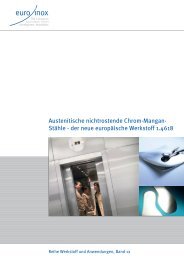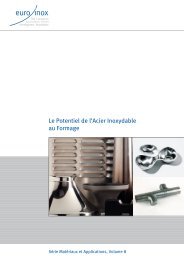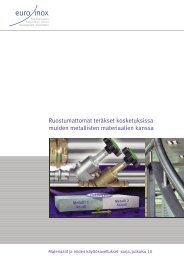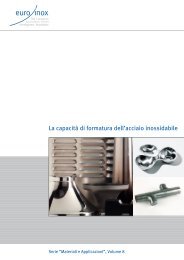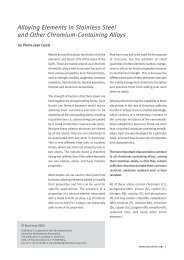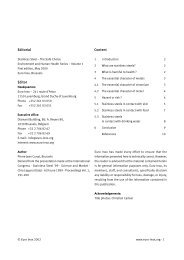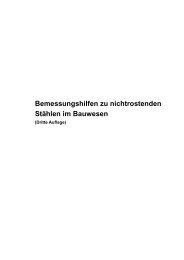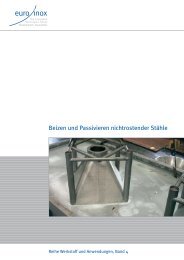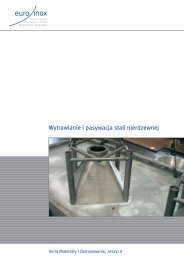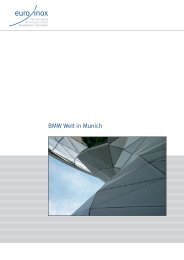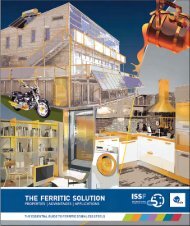Innovative Stainless Steel Applications in transport ... - Euro Inox
Innovative Stainless Steel Applications in transport ... - Euro Inox
Innovative Stainless Steel Applications in transport ... - Euro Inox
Create successful ePaper yourself
Turn your PDF publications into a flip-book with our unique Google optimized e-Paper software.
Grade 1.4318 sta<strong>in</strong>less steel was supplied to the DOLTRAC project <strong>in</strong> cold-worked<br />
2H+C850 and 2H+C1000 conditions. Experimental hollow sections from 1.4318<br />
2H+C850 strip were also manufactured for the project.<br />
Table 3. Typical chemical composition of the DOLTRAC project 1.4318 heats (<strong>in</strong> weight %).<br />
C S Si Mn Cr Ni N<br />
0.025 0.001 0.49 1.21 17.5 6.8 0.120<br />
Grade 16-7Mn<br />
Compared to standard 18/8 grade, this type of austenitic sta<strong>in</strong>less alloy is constructed on<br />
the basis of a relatively low nickel content, for economic reasons – to m<strong>in</strong>imise the<br />
effects of nickel-price fluctuations. The f<strong>in</strong>al nickel content is kept as low as possible by<br />
mak<strong>in</strong>g chemistry adjustments to achieve the overall target characteristics, pay<strong>in</strong>g<br />
particular attention to corrosion properties and austenite stability. This type of solution<br />
usually <strong>in</strong>volves develop<strong>in</strong>g steels with higher mechanical properties and meets design<br />
requirements <strong>in</strong> most relevant areas, while exhibit<strong>in</strong>g certa<strong>in</strong> limitations <strong>in</strong> terms of<br />
corrosion behaviour.<br />
Recent developments <strong>in</strong> the low-nickel AISI 200-series alloys have led to a nickel<br />
content of a m<strong>in</strong>imum of 4 % <strong>in</strong> several load-bear<strong>in</strong>g structural applications. However,<br />
high-strength austenitic grades with extremely low nickel content, such as the<br />
experimental 16-7Mn alloy used <strong>in</strong> the BUS project, may show a risk of delayed<br />
crack<strong>in</strong>g. Still, this experimental grade is <strong>in</strong>cluded as a representative of the AISI 200<br />
series of steels, to demonstrate their future potential (Table 4). Advances <strong>in</strong> alloy design<br />
have recently led to the <strong>in</strong>troduction of a “<strong>Euro</strong>pean” chromium-manganese sta<strong>in</strong>less<br />
steel, EN 1.4618, which is believed to have significant potential <strong>in</strong>, for example,<br />
<strong>transport</strong> applications.<br />
Table 4. Typical chemical composition of the BUS project 16-7Mn heats (<strong>in</strong> weight %).<br />
C S Si Mn Cr Ni Mo Cu N<br />
0.051 0.001 0.81 7.36 16.50 1.59 0.08 2.86 0.191<br />
Grade 1.4003 (UNS 40977)<br />
This is a 10.5 to 12.5 % ferritic sta<strong>in</strong>less steel grade, with good mechanical, form<strong>in</strong>g and<br />
corrosion-resistance properties (Table 5). It provides the benefits of high abrasion-<br />
resistance and wear-resistance and can be readily welded (not only <strong>in</strong> light thicknesses)<br />
us<strong>in</strong>g numerous conventional and high-power techniques, such as MIG/MAG, GTAW,<br />
LBW or resistance-weld<strong>in</strong>g techniques.<br />
Grade 1.4003 is far more corrosion resistant than mild steel. It offers good durability<br />
and low ma<strong>in</strong>tenance costs – even unpa<strong>in</strong>ted or uncoated <strong>in</strong> some applications. Pa<strong>in</strong>t<strong>in</strong>g,<br />
23



